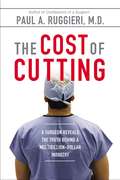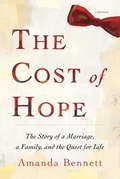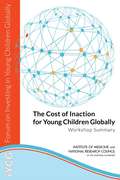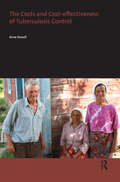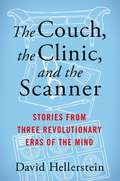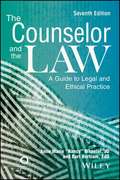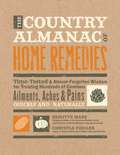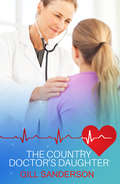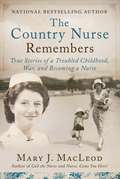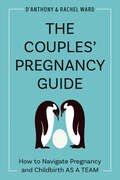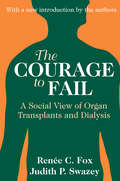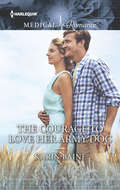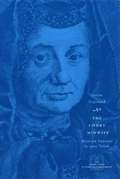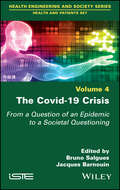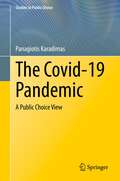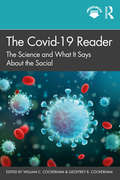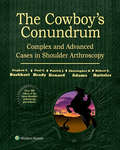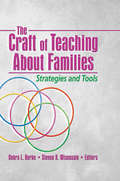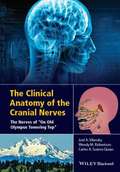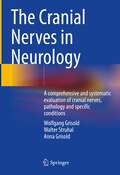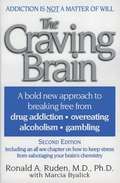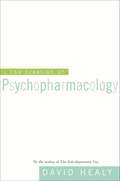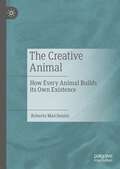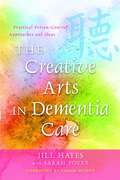- Table View
- List View
The Cost of Cutting
by Paul A. RuggieriWhy is surgery so expensive? Surgeon Paul A. Ruggieri reveals little-known truths about his profession--and the hidden flaws of our healthcare system--in this compelling and troubling account of real patients, real doctors, and how money influences medical decisions behind the scenes. Even many well-informed patients have no idea what may be contributing to the cost of their surgery. With up-to-date research and stories from his practice, Ruggieri shows how business arrangements among hospitals, insurance companies, and surgeons affect who gets treatment--and whether they get the right treatment. Pulling back the curtain from the hospital bed, he explains how to safeguard one's own health (and finances), and how America can make surgery more affordable for all without sacrificing quality care.
The Cost of Hope
by Amanda BennettFrom Pulitzer Prize winner Amanda Bennett comes a moving, eye-opening, and beautifully written memoir--a love story of two unusual people, their complex marriage and deep devotion, and finally, Bennett's quest to save her husband's life. When Wall Street Journal reporter Amanda Bennett meets the eccentric, infuriating, yet somehow irresistible Terence Bryan Foley while on assignment in China, the last thing she expects is to marry him. They are so different--classic and bohemian, bow ties and batik, quirky and sensible. But Terence is persistent. "You are going to be somebody," he tells her. "You're going to need somebody to take care of you." Though initially as combative as their courtship, their marriage brings with it stormy passion, deep love and respect, two beloved children, and a life together over two decades. Then comes illness, and the fight to win a longer life for Terence. The Cost of Hope chronicles the extraordinary measures Amanda and Terence take to preserve not only Terence's life but also the life of their family. After his death, Bennett uses her skills as a veteran investigative reporter to determine the cost of their mission of hope. What she discovers raises important questions many people face, and vital issues about the intricacies of America's healthcare system. Rich in humor, insight, and candor, The Cost of Hope is an unforgettable memoir, an inspiring personal story that sheds light on one of the most important turning points in life.From the Hardcover edition.
The Cost of Inaction for Young Children Globally: Workshop Summary
by Kimber Bogard"The Cost of Inaction for Young Children Globally" is the summary of a workshop hosted by the Institute of Medicine Forum on Investing in Young Children Globally in April 2014 to focus on investments in young children and the cost of inaction. Participants explored existing, new, and innovative science and research from around the world to translate this evidence into sound and strategic investments in policies and practices that will make a difference in the lives of children and their caregivers. This report discusses intersections across health, education, nutrition, living conditions, and social protection and how investments of economic, natural, social, and other resources can sustain or promote early childhood development and well-being.
The Costs and Cost-effectiveness of Tuberculosis Control (AUP Dissertation Series)
by Anna VassallTuberculosis is a leading cause of ill-health and death in low and middle income countries. Tuberculosis control is essential for achieving the Millennium Development Goals relating to health by 2015. However, despite efforts made to expand tuberculosis control over the past decades, tuberculosis remains a serious global health problem. This book aims to assist the expansion of tuberculosis control by adding to the evidence on the cost-effectiveness of different tuberculosis control strategies. It presents research from five countries: Egypt, Ethiopia, Syria, Peru and Ukraine. It examines the implementation of the World Health Organization recommended strategy, Directly Observed Treatment Strategy (dots). New technologies currently being developed to tackle drug resistance are also assessed. Emphasis throughout is placed on the importance of health systems and the costs for patients accessing treatment. This book is essential reading for anyone interested in economic aspects of tuberculosis control.
The Couch, the Clinic, and the Scanner: Stories from Three Revolutionary Eras of the Mind
by David HellersteinOver the past several decades, psychiatry has undergone radical changes. After its midcentury heyday, psychoanalysis gave way to a worldview guided by the Diagnostic and Statistical Manual, which precisely defined mental disorders and their treatments; more recently, this too has been displaced by a model inspired by neuroscience. Each of these three dominant models overturned the previous era’s assumptions, methods, treatment options, and goals. Each has its own definitions of health and disease, its own concepts of the mind. And each has offered clinicians and patients new possibilities as well as pitfalls.The Couch, the Clinic, and the Scanner is an insightful first-person account of psychiatry’s evolution. David Hellerstein—a psychiatrist who has practiced in New York City since the early 1980s, working with patients, doing research, and helping run clinics and hospitals—provides a window into how the profession has transformed. In vivid stories and essays, he explores the lived experience of psychiatric work and the daunting challenges of healing the mind amid ever-changing theoretical models. Recounting his intellectual, clinical, and personal adventures, Hellerstein finds unexpected poetry in hallways and waiting rooms; encounters with patients who are by turns baffling, frustrating, and inspiring; and the advances of science. Drawing on narrative-medicine approaches, The Couch, the Clinic, and the Scanner offers a perceptive and eloquent portrayal of the practice of psychiatry as it has struggled to define and redefine itself.
The Counselor and the Law: A Guide to Legal and Ethical Practice (6th Edition)
by Anne Marie Wheeler Burt BertramAttorney Wheeler, who has experience with counselors and the mental health field, and Bertram, a counselor, marriage and family therapist, and counselor educator, help counselors and other mental health professionals understand the legal and ethical dilemmas that can arise in practice. They overview the counseling profession, counseling relationship, and law and ethics, and discuss federal and state laws; civil malpractice liability and licensure board complaints; confidentiality, privilege, and privacy; duties to report, warn, or protect; suicide and threats of harm to self; professional boundaries; records and documentation; and managing the counseling practice. This edition has a new chapter on the use of social media and other Internet-related issues, updates to the Health Insurance Portability and Accountability Act (HIPAA) through the Health Information Technology for Economic and Clinical Health (HITECH) Act and regulations, a new legal/ethical decision-making model, and discussion of legal risks for counselor educators, such as recent court cases involving students' work with lesbian, gay, bisexual, and transgender clients.
The Counselor and the Law: A Guide to Legal and Ethical Practice (Seventh Edition)
by Anne Marie Wheeler Burt BertramIn this seventh edition of The Counselor and the Law, each chapter has been updated to reflect changes in the 2014 ACA Code of Ethics, findings of recent court cases, and new federal and state legislation. Attorney Nancy Wheeler and Burt Bertram, a private practitioner and counselor educator, provide a comprehensive overview of the law as it pertains to counseling practice; an in-depth look at counselors legal and ethical responsibilities; and an array of risk management strategies. Written in a clear and engaging style, this text is not only a widely used and respected resource for students, it also provides real answers for clinicians who are challenged daily to act in the best interest of their clients while minimizing the chances of becoming involved in an ethical or legal complaint. The issues surrounding civil malpractice liability, licensure board complaints, confidentiality, duty to warn, suicide and threats of harm to self, professional boundaries, records and documentation, and managing a counseling practice are addressed in detail.
The Country Almanac of Home Remedies: Time-Tested and Almost Forgotten Wisdom for Treating Hundreds of Common Ailments, Aches and Pains Quickly and Naturally
by Chrystle Fiedler Brigitte MarsNatural Wisdom for Curing Every Ache, Pain, and Ailment As little as a few decades ago, folk remedies were a part of everyday life. More often than not, our grandparents would go to their garden or kitchen pantry before they went to a doctor to treat everyday health complaints. Today, scientific studies are proving what Grandma knew all along--natural remedies are oftentimes just as effective as modern cures, have fewer side-effects, and cost just pennies. Moreover, natural remedies have stood the test of time. Peppermint has been used as soothe upset stomachs long before Pepto-Bismal and ginger has been used for its antibiotic properties for thousands of years in Asian medicine. Learn how to quickly and naturally treat over 100 common conditions with everyday cures: -Use Apple Cider Vinegar and Honey to break up congestion -Black or Green Teabags will take the sting out of a bad sunburn -Drink Beet, Celery, and Cucumber juice to soothe a shingles outbreak. -Inhale oil of Geranium to calm a hot flash -Apply a Witch Hazel compress to treat varicose veins -Pumpkin Seeds improve male potency -Burnt Toast soaks up internal toxins -Epsom Salt bathes heal the lymphatic system Filled with thousands of surprising cures, each entry gives multiple remedies for each condition from herbs, to healing foods, to acupressure and yoga poses. Hundreds of step-by-step illustrations show you the right way to administer a treatment from making herbal tinctures to applying a poultice. Dosage guidelines are given for every remedy as well as safety guidelines, contraindications, and when to call a doctor.
The Country Doctor's Daughter: A Heartwarming Medical Romance (Medical Romances #17)
by Gill SandersonAnother heartwarming medical romance from best-selling author Gill Sanderson! Perfect for fans of Mia Faye, Laura Scott, Helen Scott Taylor, Grey's Anatomy and ER.Readers ADORE Gill's gripping medical romances!'Remarkable writer!!' 5* author review 'A truly wonderful writer' 5* author review 'I find all of Gill Sanderson's books very readable and enjoy the escapism they give me' 5* author review 'A truly gifted writer with an enormous amount of talent and sensitivity' 5* author review Dr Kelly Blackman had come to Brittany to act as a locum doctor for three months. After the trauma she had suffered she needed time and peace to ensure that both body and mind were as good as they had been.She enjoyed working with Dr Luc Laforge and tried to ignore the occasional realisation that he was a very attractive man. Was he interested in her? It was hard to tell. And she did not want another catastrophic love affair. Perhaps though, there was an odd bond between them. Luc had suffered from an unsuccessful marriage. Now they both were cautious. Of all things it was Luc's daughter Jenny that brought them together, made them see that they were made for each other.Don't miss Gill Sanderson's enthralling medical romances, including the A Lakeland Practice and the Good, Bad and Ugly series.
The Country Nurse Remembers: True Stories of a Troubled Childhood, War, and Becoming a Nurse (The Country Nurse Series, Book Three) (The Country Nurse #3)
by Mary J. MacLeodFrom the Bestselling Author of Call the Nurse and Nurse, Come You Here!, the Moving Story of Her Young Life and Her Path to Independence through Training to Be a Nurse—"A Must-Read Suggestion for Fans of the BBC's Call the Midwife" (Booklist) Mary MacLeod's mother died in childbirth when Mary was five, an event that marked for the child a "before time"—a lost joyful time—and after. She was shunted from one relative to another while her father coped with his grief. He married again only nine months later, perhaps to have a mother for his child, but her new mum, harsh and withholding of her love, quickly exerted complete control over her thoughts and deeds, with her father oblivious. Her name was changed to her stepmother's choice of "Julia." Yet the pale, thin, quiet little girl didn't know she was unhappy: things were just the way they were. Narrating from the perspective of the child she was but with the understanding and empathy of the nurse and mother she became, the author of Call the Nurse recounts the moving, intimate, indelible story of her young life, growing up in rural England near Bath, relishing the good times when her stepmother was friendly or she helped her father in the garden, experiencing the world war—air raids and blackouts, the war effort, evacuees, German prisoners—winning a scholarship, leaving home to train for three years as a nurse, and gradually finding her way as an independent woman.
The Couples' Pregnancy Guide: How to Navigate Pregnancy and Childbirth as a Team
by Rachel Ward D'Anthony WardPractical strategies, checklists, and planning tools to help couples navigate the pregnancy, childbirth, and newborn stages togetherPreparing for the birth of your child is a life-changing experience, but it doesn&’t have to be an overwhelming one. Couples can tackle everything that needs to get done if they work together as a team, all while setting the foundation for a strong partnership that carries them through the next stage as first-time parents. The Couples' Pregnancy Guide offers supportive advice, strategies, and checklists couples need to create a plan that works for their unique relationship. There&’s no script for how things will go in pregnancy, but you can get through it with confidence and optimism when you do it together. The Couples' Pregnancy Guide features: • A month-by-month breakdown of discussion-worthy topics, from prenatal screenings and parental leave to childcare options and birth plans • Guidance on how to support your partner to improve communication, strengthen emotional attunement, and lay the groundwork for a strong parenting team •Checklists and worksheets to share responsibilities and empower non-birthing partners, and brainstorm solutions when joint decisions are particularly tricky •Practical advice for challenges like easing tight finances, moving past communication impasses, and advocating for yourself in medical settings
The Courage to Fail: A Social View of Organ Transplants and Dialysis
by Judith P. SwazeyThe title of this profound work conveys the bold, uncertain, and often dangerous adventure in which medical professionals and their organ transplant and dialysis patients are engaged. Built around a series of case studies, The Courage to Fail is the product of collaborative first-hand research concerned with various social phenomena generated by transplantation and dialysis. The authors examine the individuals involved and the workings and atmosphere of some of the medical centers in which these forms of therapy have been developed. They examine ""gift-exchange"" dimensions of transplantation: the transcendent and tyrannical aspects of the ""gift of life"" that transplants entail for donors and recipients-and for medical professionals as well. They also analyze the dilemma of uncertainty inherent in medicine, which occurs with particular force in the development of such experimental techniques.Since publication of the original edition, the authors have continued to follow social and medical developments surrounding organ transplants and dialysis. In their new introduction, they discuss transplantation as a gift of life, how and when death occurs, efforts to procure more organs, and organ replacement and issues of equity. This book will be of interest to physicians, medical students, medical sociologists, and anyone interested in the history of and issues surrounding organ transplantation and dialysis.
The Courage to Love Her Army Doc
by Karin BaineTaking chances Dr. Joe Braden took a posting as locum on a remote Fijian island to escape his memories. But he finds the solace he seeks in the unlikeliest of places...the arms of captivating Dr. Emily Clifford. Born with a distinctive birthmark, Emily has spent years hidden behind a mask of makeup. Yet Joe makes her feel beautiful in her skin for the first time ever. She's been burned before, but if she can find the courage to love her army doc she can claim the happy-ever-after she's dreamed of...
The Court Midwife
by Justina Siegemund Lynne TatlockThe Court Midwife contains descriptions of obstetric techniques of midwifery and its attendant social pressures and riveting birthing scenes, sworn testimonials by former patients, and a brief autobiography.
The Covid-19 Crisis: From a Question of an Epidemic to a Societal Questioning, Volume 4
by Bruno Salgues Jacques BarnouinThe threats of emerging diseases have shaken certainties about health systems, the effectiveness of governance, lifestyles and the reality of national sovereignty.The Covid-19 Crisis analyzes the global issues related to the emergence of the SARS-CoV-2 virus through investigations and reflections related to both the epidemic itself (epidemiology, computerized surveillance tools and vaccines) and to the societal issues it raises (work, innovation, religious practices, behaviors and societal models).This eclectic approach highlights scientific working methods that meet the requirements of health crises, as well as technical solutions and societal practices adapted to epidemic situations. It also presents feedback and testimonies.
The Covid-19 Pandemic: A Public Choice View (Studies in Public Choice #42)
by Panagiotis KaradimasThis monograph evaluates public policy responses to the Covid-19 pandemic through a public choice lens. The book compares two prominent, albeit mutually exclusive, theories in social sciences—public interest theory and public choice theory—and explores how their predictions perform within the framework of the Covid-19 pandemic. The chapters present different pandemic policies alongside empirical data in order to draw conclusions about their efficacy, and, in turn, draw conclusions about the veracity of each theory. By the end of the volume, the reader will be able to draw their own conclusions about whether the pandemic policy responses served the public interest, as public interest theory suggests, or the personal interests of the politicians who implemented them, as public choice theory holds.
The Covid-19 Reader: The Science and What It Says About the Social
by William C. Cockerham; Geoffrey B. CockerhamThis reader offers some of the most important writing to date from the science of COVID-19 and what science says about its spread and social implications. The readings have been carefully selected, introduced, and interpreted for an introductory or graduate student readership by a distinguished medical sociology and political science team. While some of the early science was inaccurate, lacking sufficient data, or otherwise incomplete, the author team has selected the most important and reliable early work for teachers and students in courses on medical sociology, public health, nursing, infectious diseases, epidemiology, anthropology of medicine, sociology of health and illness, social aspects of medicine, comparative health systems, health policy and management, health behaviors, and community health. Global in scope, the book tells the story of what happened and how COVID-19 was dealt with. Much of this material is in clinical journals, normally not considered in the social sciences, which are nonetheless informative and authoritative for student and faculty readers. Their selection and interpretation for students makes this concise reader an essential teaching source about COVID-19. An accompanying online resource on the book’s Routledge web page will update and evolve by providing links to new readings as the science develops.
The Cowboy's Conundrum: Complex And Advanced Cases In Shoulder Arthroscopy
by Stephen S. BurkhartObtain optimal outcomes with masterful guidance! The Cowboy’s Conundrum: Complex and Advanced Cases in Shoulder Arthroscopy brings you step-by-step advice from preeminent orthopaedic surgeons, helping you to successfully perform even the most challenging techniques and achieve the best results. Authored by Stephen S. Burkhart, MD and his expert team of surgeons, creators of bestselling titles A Cowboy’s Guide to Advanced Shoulder Arthroscopy and The Cowboy’s Companion: A Trail Guide for the Arthroscopic Shoulder Surgeon, The Cowboy’s Conundrum brings you the collective wisdom of world authorities who have been intimately involved in pioneering and refining today’s approaches to minimally invasive shoulder surgery. Dr. Burkhart uses his trademark “cowboy” flair to communicate essential clinical pearls in an approachable and entertaining manner.
The Craft of Teaching About Families: Strategies and Tools
by Debra L. Berke Steven K. WisensaleLearn how to develop and teach effective courses on the vital issues of family lifeThe Craft of Teaching About Families presents a variety of course designs, evaluation methods, and teaching techniques and strategies that can be used to address the complexities of family life. This unique book prepares students for the challenges they&’ll face as they leave the campus for the classroom, providing them with the problem-solving skills they&’ll need for success. The book&’s contributors-a distinguished panel of family scientists, sociologists, public policy analysts, psychologists, and extension specialists-examine a range of topics, including family law and policy, advocacy, parenting skills, international families, and diversity.One of the few books geared to teaching family studies, particularly family policy and family law, The Craft of Teaching About Families reaffirms the importance of teaching in a time when controversial family issues receive constant attention from the media, the courts, and the legislatures. In addition to articles on family policy, family law, marriage and the family, family interaction and dynamics, and cultural diversity, the book addresses empirical assessments of internships and service learning activities in family-oriented courses, the effectiveness of various teaching strategies, including role-playing, classroom simulations, and Web-based assignments. Divided into three sections for ease of use, The Craft of Teaching About Families examines:Family Law and Family Policy how to build writing skills through the preparation of court briefs and policy memos how to use cooperative learning research teams to teach family law how to design better courses by understanding students&’ perceptions of family policy issues how cooperative extension can help involve families in the policymaking processFamily Dynamics how to develop a course in father-daughter relationships how to incorporate parenting education workshops into a parent-child relationship course how to prepare students to become competent multicultural educators how to develop a course on international families from a family strengths perspective how to develop a new framework for teaching family resources managementTeaching Techniques in Family Science how to incorporate effective role-playing into the syllabus how to use small-group work to create a positive experience in the classroom how to educate future teachers about psychological abuse how to teach students about forgiveness toward those who have hurt them how to analyze the results of service-learning assignments in family diversityThe Craft of Teaching About Families is an essential resource for professionals who teach about individuals and families at any level, in any setting-formal or informal.
The Cranial Nerves
by Joel A. Vilensky Carlo A. Suarez-Quian Wendy RobertsonThe cranial nerves are an endlessly fascinating family of twelve nerves that have a dramatic impact on our daily lives. A dysfunction of the cranial nerves can cause loss of vision or double vision, loss of smell, poor balance, or loss of muscle function, and can also be an indicator of underlying neurological disorders. The Clinical Anatomy of the Cranial Nerves: The Nerves of "On Old Olympus Towering Top" is an engaging and accessible book on the anatomy and clinical importance of these unique nerves.. Thetext opens with a brief introduction of key neuroanatomical concepts that relate the clinical and anatomical sections that follow. Additionally, this book uniquely provides a detailed description of the bones of the head and face in order for the reader to understand the routes taken by the cranial nerves through the skull. Chapters then detail each nerve and its unique impact in relationship to our senses, motor function, and health. Vividly illustrated and supported by real-life clinical cases, the book will appeal to anyone wishing to gain a better understanding of the cranial nerves. Merging anatomical and clinical information with intriguing clinical cases, The Clinical Anatomy of the Cranial Nerves: The Nerves of "On Old Olympus Towering Top" introduces readers to the anatomy and diverse function of this intriguing family of nerves.
The Cranial Nerves in Neurology: A comprehensive and systematic evaluation of cranial nerves, pathology and specific conditions
by Wolfgang Grisold Walter Struhal Anna GrisoldThis book presents a complete summary about the 12 pairs of cranial nerves (CN). They control much of the motor and sensory functions of the head and neck such as smell, sight, eye movement, and feeling in the face. The CN also control balance, hearing, and swallowing. The examination of the CN is an important part of the clinical neurological examination. Additionally, to the anatomy, extensive knowledge about further diagnostic tools are necessary such as neuroimaging, and electrophysiology. The book is divided into three parts: a general part with anatomy and imaging, a systematic part grouping the 12 pairs of cranial nerves, and a part describing cranial nerve functions in specific conditions and diseases.
The Craving Brain: A Bold New Appraoch to Breaking Free from Drug Addiction, Overeating, Alcoholism, Gambling (Second Edition)
by Marcia Byalick Ronald A. RudenIn the Craving Brain, Dr. Ronald Ruden asserts that the roots of addiction most definitely do not lie in our character. Rather, they lie in a complex chain reaction that originates in an ancient survival mechanism in the brain. When this system is inappropriately activated, it drives the body to crave, sometimes with addictive behavior as the end result. In clear, straightforward language, Dr. Ruden outlines his remarkable successful treatment program which he believes can cure this problem. The Craving Brain offers crucial insights into the world of addiction. This revolutionary book will bring hope to millions of people who suffer from a wide range of addictions, from gambling and alcohol to drugs and food.
The Creation of Psychopharmacology
by David HealyDavid Healy follows his widely praised study, The Antidepressant Era, with an even more ambitious and dramatic story: the discovery and development of antipsychotic medication. Healy argues that the discovery of chlorpromazine (more generally known as Thorazine) is as significant in the history of medicine as the discovery of penicillin, reminding readers of the worldwide prevalence of insanity within living memory. But Healy tells not of the triumph of science but of a stream of fruitful accidents, of technological discovery leading neuroscientific research, of fierce professional competition and the backlash of the antipsychiatry movement of the 1960s. A chemical treatment was developed for one purpose, and as long as some theoretical rationale could be found, doctors administered it to the insane patients in their care to see if it would help. Sometimes it did, dramatically. Why these treatments worked, Healy argues provocatively, was, and often still is, a mystery. Nonetheless, such discoveries made and unmade academic reputations and inspired intense politicking for the Nobel Prize. Once pharmaceutical companies recognized the commercial potential of antipsychotic medications, financial as well as clinical pressures drove the development of ever more aggressively marketed medications. With verve and immense learning, Healy tells a story with surprising implications in a book that will become the leading scholarly work on its compelling subject.
The Creative Animal: How Every Animal Builds its Own Existence
by Roberto MarchesiniThis book deals with the theme of creativity in the animal world, conceived as a basic function for adapting to specific situations and as a source of innovations and inventions. Creativity is a fundamental resource for the individual who always has a leading role in conduct. To explain creativity, the book focuses on the concept of animal subjectivity, providing a new explanatory model of behavior capable of overcoming the image of the animal moved by automatisms. This model does not use consciousness as a necessary condition, but is based: 1) on affective components, such as behavioral motives, and 2) cognitive, as tools used by the subject to carry out his purposes. Particular attention is paid to the learning processes showing the subjective character of the experience. One topic addressed is the role of creativity in the evolution of living beings: how an invention, by modifying the niche characteristics, is able to change the selective pressures and the trajectory of phylogeny. Roberto Marchesini explains that creativity is a factor that is anything but rare or exceptional in the animal world—it constitutes a fundamental quality for many aspects of animal life.
The Creative Arts in Dementia Care
by Jill Hayes Sarah PoveyThe physical care of people with dementia is of vital importance, but so too is their emotional, social, mental and spiritual wellbeing. The creative arts are gaining increasing recognition not only as a tool for delivering effective person-centred dementia care, but also for attending to soul as well as body. Encouraging those who care for people with dementia to develop their own creative skills, this book provides a creative map of care with easy-to-follow examples and detailed case studies. After explaining why adopting a creative approach is central to effective dementia care, the authors go on to discuss meditation, singing, movement and storytelling, describing the therapeutic benefits of each and giving practical examples of how they can be used with individuals or groups. They also look at the importance of creative supervision in promoting creativity and creating a safe space for honest interpersonal connection: an essential foundation for effective teamwork. This book will be an invaluable resource for anyone involved in the care of a person with dementia, including professional staff in residential and nursing homes, hospitals and day centres, families and other non-professional carers.
